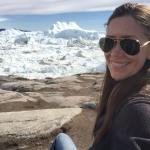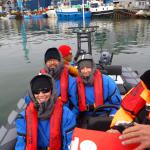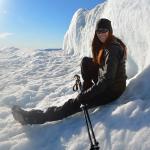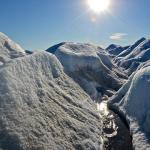© 2011 Sabrina Swenson. All Rights Reserved.
Greenland
I've flown over it more than a thousand times. Flying from Europe back to the U.S. for work, I've seen Greenland from the air a lot over the past two decades. I always thought it's stark, icy, glacier-filled terrain had a certain beauty about it. And so, in July, partly in celebration of my 49th birthday, I decided to stop. I wanted to have a closer look at this place I've seen so often from six miles up.
Greenland is an autonomous constituent country within the Kingdom of Denmark. It's the world's largest island (although Australia is larger, it is considered a continental land mass). It's sparsely populated with only 56,480 inhabitants of whom 88% are Greenlandic Inuit. The remaining 12% are of European descent, mainly Greenland Danes. Roughly 80% of the surface of Greenland is covered by an ice sheet. Most Greenlanders live along the fjords in the south-west of the island, which has a relatively mild climate. It's economy is highly dependent on fishing, with fishing accounting for more than 90% of Greenland's exports.
My trip started with a flight to Copenhagen, Denmark. There are only two ways to arrive in Greenland via commercial airlines, through Denmark or Iceland. I flew into the small town of Ilulissat on the Western coast. It lies approximately 220 miles North of the Arctic Circle. I found a hostel that was very basic, but adequate for my needs. I dropped my bag and set off wandering around this small town. Ilulissat, interestingly, means icebergs in the Greenlandic language.
I decided to hit the highlight of the immediate area first and headed straight for the Ilulissat ice fjord. On the walk there, I passed a large area that was home to the areas many sledge dogs. I saw about 75 dogs in the area chained near their dog houses. It was off season for them, so they were simply hanging out, playing and barking at each other. I had seen several signs throughout the village stating that you should never approach the dogs on your own when walking around town. They are not house pets, but rather working dogs and as such, are not used to being petted, especially by strangers. Most had thick, fluffy white fur and were adorable looking. It was hard to see such beautiful animals chained. After passing the area, I continued on the road and as I walked, the fjord unfolded in front of me and with it, the Jakobshavn glacier. It was magnificent! This glacier is the most productive glacier in the Northern hemisphere. It flows at a rate of 66-115 feet per day, resulting in around 20 billion tons of icebergs calving off and passing out of the fjord every year. Icebergs breaking from the glacier are often so large, they are too big to float down the fjord and lie stuck on the bottom of it's shallower areas, sometimes for years until they are broken up by the force of the glacier and icebergs further up the fjord. I sat on the ground for at least an hour and just stared at this beautiful sight. It was peaceful, quiet and a brilliant white. Natural beauty at it's best.
The following day I got on a boat to have a float around the area and see the Jakobshavn glacier from the water. It was equally stunning from the water line. We sailed around for a couple hours marveling at the sometimes gigantic icebergs floating around Ilulissat. From the boat I could see the towns brightly colored houses and buildings.
The following morning I boarded a small motor boat and headed North, about 30 minutes to Oqaatsut for sea kayaking. This small village community of only about 45 people had a school, church, grocery store and small restaurant. Other than that, there wasn't a whole lot except for the jaw-dropping scenery. We got in our kayaks and headed for some of the larger icebergs. We maintained our distance in case the icebergs calved and on numerous occasions, had the opportunity to see this happen. When it does, it sounds like a shot has been fired in the distance. Immediately thereafter a portion of the iceberg, of varying size, breaks off and drops into the water with a great crash. It was amazing to watch. We paddled around for over an hour zigzagging through the icebergs and eventually headed back to shore. We got out of our dry suits and back into our normal clothes. We then had a treat while in this small community as one of the local women was making us lunch. She was 75 and lived in her own home. The two guides, two other kayakers and I all sat at a long table with her and ate the hearty stew and potatoes she had fixed. She had many windows in her house and it was amazing to have such a stunning view out each and every one. We finished the huge meal and after thanking her headed on our way, back to Ilulissat.
The following morning I boarded Air Greenland for a 45 minute flight South to Kangerlussuaq, Greenland's main air transport hub and the site of the largest commercial airport in Greenland. Kangerlussuaq was founded in 1941 by the U.S. Army Air Forces following the fall of Denmark to Germany in WWII. The U.S. forces assumed security for Greenland. The base briefly came under Danish control in 1950, but following concerns about the Cold War, a new agreement had the U.S. open the base in 1951. Around 1992 the last U.S. Air Force personnel left Kangerlussuaq as the usefulness of the base had greatly diminished at that point. A small village, with a population of approximately 500, it is almost entirely reliant on the airport and tourism. I found another rustic hostel and dropped my bag. I then found a guide and went on a ride looking for the muskox which live in the wild near Kangerlussuaq. My driver started by driving me around town where I saw numerous buildings built by the U.S. military during WWII still standing. Still in fairly good condition after all these years, locals simply turned these buildings into something they could use.
After spinning around town, we headed into the countryside. It wasn't long before we found one of the huge beasts grazing on the local shrub, Arctic Willow. The muskox are massive and can charge. As a result, we didn't get too close with the vehicle. We watched it eat and I marveled at it's massiveness. The thick shaggy-haired animal weighs on average 630 pounds for an adult. It's twisted horns had one broke off, most likely from a fight. It was spooked at one point and ran into thicker Arctic Willow. In spite of it's massive girth, it can reach up to 37 m.p.h. We eventually rode on and although didn't see any more muskox, we took in some sweeping views of the town below and the beautiful natural scenery which surrounds it. I headed back to my hostel and went to bed early. Since it was July, the midnight sun was in full force and sleep was difficult. My hostel in Ilulissat had black-out curtains, so I was able to sleep easily, however, this hostel did not. The thin, light-colored curtains were no match for the bright sun and so I tossed and turned all night.
The next morning I had breakfast and then headed to the meeting point for the highlight of my trip; a trek and camp on the ice cap! There were nine of us plus a guide. After the meet and briefing, we were on our way to the immense ice cap in a huge bus. We stopped along the hour and a half drive and spotted a reindeer and many sweeping landscapes. We continued on the increasingly worse roads until we arrived at the start of the trek. We got out and unloaded the gear which included food, tents, sleeping bags, etc. The Greenland ice sheet is a vast body of ice covering 660,000 square miles. It lay out in front of us as a huge swath of white. Since we were on slightly higher terrain, we could see it lay below us immense and foreboding.
We headed down towards it's beginning and once on the ice, stopped to put on our crampons. With spikes now on our shoes and poles in hand, we proceeded towards camp ice cap approximately 45 minutes away. It was the first time I had ever used crampons and it took a bit of use before I felt comfortable in them. On the way to camp, a few of the guys pulled the pulks (sleds) filled with our gear. During the Summer days some of the ice melts creating streams and small lakes. I always thought of the ice cap as being smooth, but it is anything but. It's jagged with hills and crevasses. At one point we saw another small group who were on a day trek (not overnighting) and one of the ladies, unfortunately, found out how sharp the ice was. She had fallen and hit her face on the ice. It's like glass and her face was badly cut. We eventually made it to the main tent which is kept in place on the ice cap. It included a cot for the guide to sleep, containers with food, a propane heater and other supplies including the most important port-o-potty, Arctic style! Once we arrived at the large, orange tent we took our crampons off and set up camp. We each had our own tent to erect. We were given mats as well as an inflated mat to sleep on. On top of that we had heavy sleeping bags and thick sleeping bag liners. It was the first time while setting up a tent that I had to drive the spikes in each corner by screwing them into the ice. Meanwhile, the guide put up the toilet tent. It was a narrow, tall tent which was high enough you could stand in it. It was made complete with a bucket with toilet seat cover on top of it, a shelf for toilet paper and antibacterial gel. It was rudimentary, but functional. After setting up our homes for the night, we donned the crampons and once again were on the move. We walked a couple hours and got used to walking up and down steep ice. It's unnatural for a human to walk straight up and down such steep angles, but with the crampons, it was made possible. Most important was keeping your whole foot on the ground, or the spikes wouldn't hold you in place. We came across brilliant blue, smaller lakes and numerous streams which we walked through or jumped over. At one point we stopped high on a hill and looked down at what now appeared to be our tiny camp. Our small tents set against the enormous landscape made you realize how big this ice cap really was. We continued on our way exploring the area and eventually headed back for something to eat.
Numerous times throughout our trek we heard the ice cracking. Our guide said it's common during the day when the sun is strong and it starts to melt the ice. Much like a glacier calving, it sounded like a shot in the distance. Of course, it's always a bit disconcerting, as you hope it's not cracking under you!
We got back to the main tent and warmed up around the propane heater. The guide opened up the containers which were kept in the tent and named off the possible dinner options. Chicken curry, goulash and other "fine", dried meals were available. The only step before eating... add hot water! Earlier, two of the trekkers had chipped off some ice and put it in the massive pot to be heated. With the water now boiling, and once we all had our meal of choice, we filled the containers with hot water. We folded down the package until the appropriate amount of time had passed and our dinner was served. We eventually said goodnight and retreated to our prospective tents. I got some great pictures of the midnight sun before retreating for the night. The light was perfect for picture taking.
We were all up early and in the main tent for breakfast. Sandwiches with meat, cheese and Nutella were offered along with coffee and tea. We kitted up and went trekking again, this time for several hours. Now with a bit more confidence in using the crampons, we did a more difficult trek. Trekking on this remote terrain was simply one of my most favorite things to do, ever. As far as the eye could see, it was ice cap. After seeing some of the most beautiful views, I think, on Earth, we eventually headed back to camp and had the same meat and cheese sandwiches for lunch, however, this time our guide produced a panini maker. Holding the contraption over the propane heater produced lovely, toasted sandwiches. After lunch we packed up our prospective tents and loaded the pulks with our gear. Before leaving, we had to screw the stakes on the main tent back into the ice. As the sun is so strong, the surface layer is always melting during the day. As such, one day your tent stakes are firmly holding your tent in place and the next day, the sun has melted the ice and your tent stakes are now laying in a puddle of water. And so, we had to screw all the stakes back into the ice and put a mound of chipped ice over each one, hoping they stayed in place until the next group of trekkers arrived. The guide dismantled the "toilet" and we were on our way back to civilization. Another 45 minutes on the ice and we were back at the truck which still remained in spite of the fact the keys had been left in her. We packed up the gear in the big beast of a vehicle and headed back to Kangerlussuaq.
My visit of Greenland now over, I wished I had allowed for extra days there. After traveling 90+ countries, some stand out more than others. This huge island which I've seen so often from the air, simply captured my heart. It was one of my most favorite trips ever. I will always remember it fondly.
July, 2017




